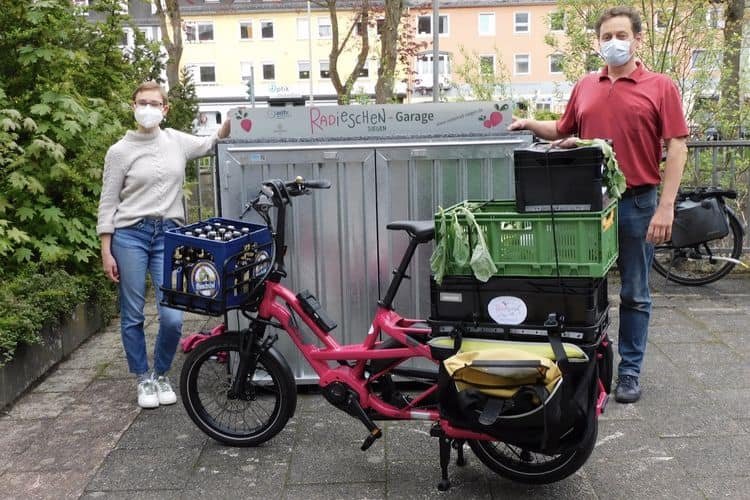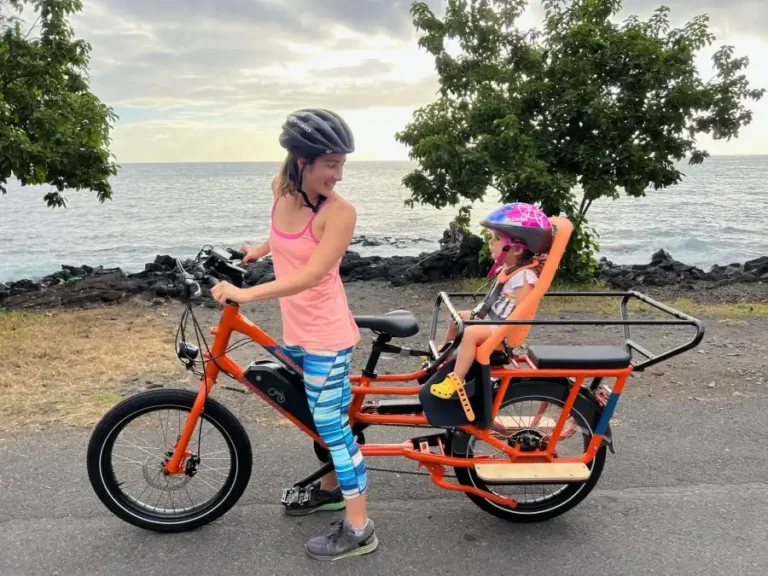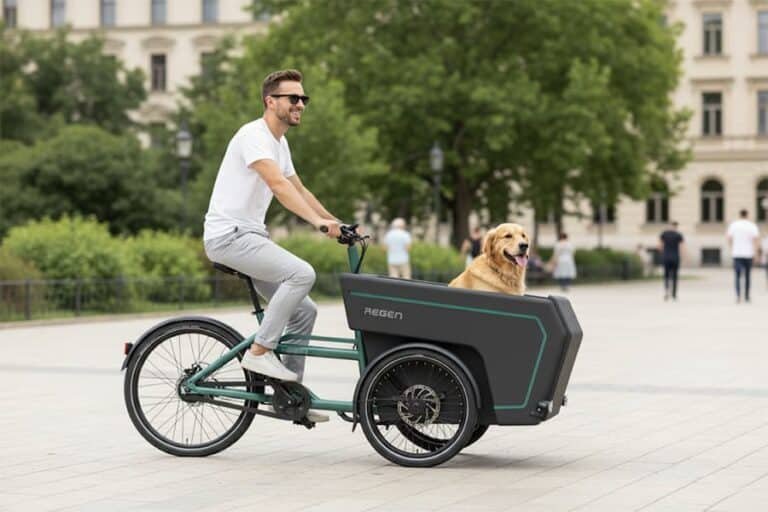電動バイクの人気は世界的に急上昇しているが、このブームの中で新たなカテゴリーが本格的な盛り上がりを見せている: 電動カーゴバイク.Regenはカーゴ用e-bikeに特化した企業として、電動カーゴバイクと通常の電動バイクの比較についてよく質問を受けます。この記事では、OEM/ODMカーゴバイク・ソリューション・プロバイダーであるRegenの視点から、デザイン、機能性、ターゲットとするユースケース、ビジネスの可能性の違いについて、私たちの生の洞察をお伝えします。私たちの目標は、自転車販売店、流通業者、その他のB2Bバイヤーが、特にカーゴバイクセグメントへの進出を検討している場合に、重要な違いとビジネスチャンスを理解できるようにすることです。
| 特徴 | 通常の電動自転車 | 電動カーゴバイク |
|---|---|---|
| 主要用途 | 個人通勤 | 貨物・旅客輸送 |
| 負荷容量 | 250ポンドまで | 300~550ポンド |
| デザイン・フォーカス | スピードと敏捷性 | 安定性と強さ |
| 電気補助 | 標準ペダルアシスト | 重荷重用に強化 |
| 典型的なユーザー | 通勤客、レクリエーション・ライダー | 家族、企業 |
デザイン&ビルドフレームとコンポーネントの主な違い
一見したところ、通常の電動自転車(e-bike)と電動カーゴバイクは、どちらもおなじみのペダル、2つの車輪(ほとんどの場合)、バッテリー駆動のモーターを備えている。しかし、カーゴ用e-bikeのデザインとエンジニアリングは、その特殊な目的に対応するために大きく異なっている。 基本的な違いは、カーゴバイクは通常の自転車よりも多くの荷物を積めるように作られていることだ。.一般的な自転車とは異なり、カーゴバイクは通常、次のような特徴があります。 拡張フレームまたは専用カーゴエリアを装備 かなりの荷物を積載できる。要するに、カーゴバイクは、荷物、食料品、工具、子供など、余分な乗客や貨物を運ぶことを目的に作られている。 自動車よりも小さく、環境に優しい。 .この基本的な設計思想は、一般的に最小限の荷物(おそらくバックパックかパニア)を積んで個人で移動するために設計された通常のe-bikeとは対照的である。
フレームとジオメトリー: 重い荷物を扱うために、カーゴ用e-bikeは強化フレームを使用し、多くの場合、ホイールベースを長くしたり、サポート構造を追加したりしている。多くのカーゴバイクのフレームは、高張力素材を採用し、安定性のために戦略的なジオメトリーを採用している。例えば ダブルトップチューブ一般的な通勤用e-bikeではほとんど必要とされない機能である。実際、カーゴバイクはこれまで、基本的に以下のような機能を備えてきた。 「標準的な自転車の強化版より頑丈なフレームで作られ、大型のバスケットやカーゴボックスを収納できるようにホイールが小型化されることもある。現代のカーゴE-BIKEは、ロングテールバイク(荷物/乗客用の拡張リアキャリア)やフロントローディング「バクフィーツ」バイク(車輪の間の低い位置に荷箱を取り付けたもの)などのデザインで、この進化を続けている。先進的なデザインとしては RS01 e-カーゴバイクのような革新的なジオメトリーも採用している。 傾斜3輪構成 これは、標準的な2輪E-BIKEをはるかに超える複雑な技術レベルである。

サイズと重量: カーゴE-BIKEが一般的に通常のE-BIKEより大きく重いのは当然だ。フレーム、カーゴボックスやプラットフォーム、強化されたコンポーネントが重量を増加させる。一般的なシティ用e-bikeの重量が20~25kgであるのに対し、カーゴ用e-bikeは35~45kg(トライクモデルではそれ以上)にもなる。その分、次のような利点がある。 容量通常のE-BIKEは、ライダー1人+リアキャリアに15~20kg程度を積載できるものが多いが、カーゴ用E-BIKEはそれ以上の積載量を扱うことができる。多くのカーゴバイクは 100~200kgの複合荷重ライダー、乗客、貨物の間で配分される。例えば、ヘビーデューティー・カーゴ・モデルの中には、次のようなオーダーで運搬できるものもある。 200キロの貨物 都市部での配送用途に適しています。この堅牢な運搬能力はビジネスにとって画期的なものだが、そのためにはより頑丈な作りが必要となる。そのため、カーゴバイクには 強化ホイール、大容量タイヤ、アップグレードされたサスペンション (もしあれば)余分な重量を支えることができる。販売店の立場からすると、カーゴe-bikeの輸送と保管には、より広いスペースと多少の筋力が必要になることは注目に値するが、耐久性の高い構造は、品質にこだわる顧客にとってセールスポイントとなる。
コンポーネントとEドライブシステム: 通常のe-bikeと貨物用e-bikeは、電気部品(モーター、バッテリー、コントローラー)が似ていることが多いが、用途に合わせて仕様が異なる場合がある。カーゴ用e-bikeは通常、以下を要求する。 高トルクモーター と堅牢なドライブトレインを備えている。荷物を積んだ自転車を坂道まで運んだり、停止状態から動かしたりするには、さらに「筋力」が必要になるため、荷物運搬用に特別にチューニングされたミッドドライブ・モーターや高トルク・ハブ・モーターを搭載したカーゴ用E-BIKEをよく見かける。 モーターの種類とそのトレードオフに関する詳しい議論は、当社のブログ記事 "正しいE-Bikeモーターの選択"一方、体重70kgのライダーが平坦な市街地を走るために設計された通常のe-bikeは、トルクよりも最高速度の効率を優先するかもしれない。さらに、カーゴバイクには より強力なブレーキシステム (重い荷物を載せても安全に停止できるようにするため(例:大型ローターを備えた油圧ディスクブレーキ)。また、チェーンリングやギア比を小さくするなど、トルクに最適化されたトランスミッションのギアリングを採用することで、体重をかけた状態でのペダリングを容易にしている場合もある。
バッテリー容量と航続距離: 通常のe-bikeもカーゴ用e-bikeも充電式リチウムイオンバッテリーを使用するが、カーゴ用e-bikeには以下のような特徴がある。 大容量バッテリーのセットアップ.理由は簡単で、重量を増やすと(さらに通常は空気抵抗が小さくなる)、モーターからより多くの電力を引き出せるからだ。多くの貨物用e-bikeは、500Whから900Whのバッテリーを搭載しており、デザインによっては、以下のようなものもある。 デュアルバッテリー 標準的なe-bikeではあまり見られない機能だ。例えば、ある種の長距離カーゴ・モデルは、配達や家族の用事を1日中こなせるように、バッテリーを2つ搭載できる(ワット時容量は2倍になる)。平均的な通勤用e-bikeには、毎日の通勤に十分なバッテリー1個(約400~500Wh)が搭載されているかもしれません。販売店としては、カーゴ用e-bikeはバッテリー・システムが大きいため、初期費用は高くつくかもしれないが、子供や荷物を載せて街中を移動する際、途中でバッテリーが切れることがないという実用的な利点があることを顧客に説明することができる。
コスト要因: カーゴ用e-bikeは特殊な構造であるため、一般的に以下のような特徴がある。 価格が高くなる 標準的なe-bikeよりも高い。余分な材料、より強力なコンポーネント、追加機能(カーゴラックやボックスなど)すべてがコストに貢献します。私たちの経験では、質の高いカーゴ用E-BIKEは、同じようなモーター仕様の一般的なE-コミューター用自転車の1.5~2倍の価格で販売されている場合がある。一般的に、カーゴバイクは、その特殊な構造と容量の増加により、通常のバイク(またはe-bike)よりも高価になる傾向があります。B2Bのバイヤーにとっては、カーゴバイクがもたらす機能性の拡大と収益機会によって、高い価格タグが正当化される可能性がある(詳細は後述)。重要なことは、ビジネスの観点からは、小売価格が高いということは、販売店にとっては1台あたりの利益率が高いということでもあるということだ。
要するにだ、 通常のe-bikeは、個々のライダーのために軽さと敏捷性を優先している。一方 電動カーゴバイクは、その軽さと引き換えに、実用性が大幅に向上している。.カーゴバイクは、拡張フレーム、タフなパーツ、大量の重量を安全に移動させることを目的とした構成など、文字通り異なる構造になっている。次に、これらの設計の違いが、どのように機能性や性能の違いに反映されるかを見てみよう。
機能性と性能:運搬力と日常走行
その設計上、通常のe-bikeとカーゴe-bikeでは、ライディング体験や機能がまったく異なる。これらの違いを理解することは、販売店が顧客にアドバイスする上で(そしてB2Bバイヤーがフリートを計画する上で)鍵となる。機能性と性能をいくつかの分野に分けて説明しよう:
運搬と容量: カーゴe-bikeの最も明白な機能的利点は、以下のとおりである。 運搬能力.通常の電動アシスト自転車では、パニアに食料品を積んだり、子供を1人乗せたりすることができる。 複数の子供、より大きなペイロード、または一度に数十のパッケージ.例えば、ファミリー向けのカーゴ用e-bikeには、チャイルドシート2つと食料品用のスペースがあるかもしれないし、業務用のカーゴ用バイクには、フロントボックスに100リットル以上の貨物容積を積めるかもしれない。これにより、通常のe-bikeでは対応できないようなユースケースが広がる。性能の観点からは、荷物を満載しても、カーゴ用E-BIKEは(うまく設計されていれば)安定性とコントロール性を維持できる。私たちが好んで使う言葉は カーゴバイクの特徴は、普通の自転車よりも多くの荷物を運ぶことができることだ。 - 子供も荷物も荷物も増える - その一方で、市街地での走行に十分な俊敏性も兼ね備えています。その積載量と俊敏性のバランスは、試乗すればすぐにお客さまがお気づきになることでしょう: 「あれだけの重量があっても、驚くほど安定している。
ハンドリングとライドフィール: 一般的なe-bikeは、次のような目的で作られている。 軽快なハンドリング.電動カーゴバイクは標準的なホイールベースとジオメトリーを持っているため、従来の自転車と同じようにコーナーリングや操縦ができる(ペダルを漕ぐとアシストがつくだけ)。対照的に、電動カーゴバイク、特にロングテールやフロントローダーは、異なる感触を持つだろう。ホイールベースが長いと回転半径が広くなり、重量配分(特に前方に荷物を積んでいる場合)により、ライダーはステアリングテクニックを調整する必要がある。初心者のライダーの中には、低速走行時や停止状態からの発進時に、カーゴバイクが少し扱いにくいと感じる人もいるが、最近のデザインではこの点が大幅に改善されている。多くのカーゴバイクは荷物を 低い 重心を安定させるためだ。 高める 移動中の安定性例えば、フロントボックスのカーゴバイクは、バランスを取るために車輪の間に重量を保ち、ロングテールは、カーゴの重量を地面に近づけて中央に保つ。さらに、3輪のカーゴトライクは、停止時に完全な安定性を提供します(信号待ちでバランスを取る必要はありません)。販売店としては、顧客にある程度の重量があるカーゴバイクを試乗させるのが賢明だ。乗り心地は通常のEバイクとは異なるように感じるだろうが、短い学習曲線で、ほとんどの人はすぐに快適になる。実際、多くのライダーが、よく設計されたカーゴ用e-bikeに乗っても、サイズに慣れてしまえば、普通の自転車と「それほど違いは感じない」と言います。
スピードと航続距離: カーゴe-bikeと通常のe-bikeは、スピードと航続距離の点でどのように比較されますか?生の速度に関しては、ほとんどのe-bike(カーゴであろうとなかろうと)は同様のアシスト制限(例えば、EUでは時速25km、米国では時速20マイルまたは時速28マイルのクラス分け)が適用されます。貨物用e-bikeは、特に荷物を積んでいる場合、重量が増えるため加速が少し遅くなるかもしれないが、強力なモーターのおかげで、他のe-bikeと同じ最高アシスト速度に達することができる。とはいえ、カーゴe-バイクが真に輝くのは次のような場合だ。 効果的 特定の作業にはスピードが必要だ。密集した都市環境では、カーゴバイクはドアツードアの配達時間で自動車やバンを上回ることができる。都市中心部では、以下のような研究結果が出ている、 カーゴバイクはバンより約60%速く配達を完了する 渋滞を迂回し、目的地に駐車できるためである。(航続距離については、前述したように、貨物用e-bikeは多くの場合、より大きなバッテリーまたはデュアルパックを搭載し、より高いエネルギー使用量を補っている。通勤に使われる通常のe-bikeは、1回の充電で50~100kmは確実に走るかもしれない。重い荷物を積んだ貨物用e-bikeは、負荷の関係で1つのバッテリーではもう少し短くなるかもしれない。しかし、デュアルバッテリーや慎重なパワーマネジメントを行えば、多くのカーゴバイクはまだ実用的な一日航続距離を達成することができる(一部のシステムでは、荷物を積んで頻繁に停車する場合、回生ブレーキが航続距離の延長に少し役立つ)。
メンテナンスと耐久性: 大きな積載量には大きな責任が伴います。カーゴ用e-bikeは通常、強化されたコンポーネント(スポークの多いホイール、頑丈なラックなど)を使用している。 より耐久性がある 毎日の酷使にディーラーやフリートマネージャーとしては、カーゴバイクが標準的なE-バイクとは異なるストレスに耐えることを予想する必要があります。タイヤは高負荷で早く摩耗し、ブレーキはハードに使用され、フレームに負担をかける質量が増えます。良いニュースは、高品質のカーゴE-BIKEは、これらの要求に対してテストされているということです(例えば、私たちのフレームは厳しいテストを受けています)。 負荷テストと規格への準拠 DIN 79010のような)。実際のところ、カーゴe-bikeのメンテナンススケジュールは、通常のe-bikeと劇的に異なるわけではありません。- しかし、ブレーキパッドやタイヤなど一部の部品は、重量があるため、交換頻度が若干高くなるかもしれません。ショップにとっての実用的なヒントのひとつは 予備部品 カーゴモデルに特化したスペアパーツ(例:超強力インナーチューブ、ロングブレーキケーブル、ヘビーデューティキックスタンド)を在庫しています。Regenは、スペアパーツの供給やテクニカルサポートを通じて、パートナーをサポートしています。 サービスセンター そのため、メンテナンスは簡単で、ダウンタイムを最小限に抑えることができる。
要約すると 通常のe-bikeは個人的な移動手段として優れている - 軽くて、速くて、乗りやすい。 一方、カーゴ用e-bikeは、"AからBへの移動だけ "をはるかに超えた能力を解き放つ。 彼らはライダーに もっと見るより多くのものを運ぶ、車での移動に取って代わる、ビジネスの配達に役立つ、などなど。次に、これらのユースケースと、なぜそれがビジネスの観点から重要なのかを掘り下げてみよう。
ターゲットとするユースケースと顧客セグメント
電動カーゴバイクを仕入れるか投資するかを決める際には、以下のことを理解することが重要である。 エンドユーザーが誰で、このバイクがどんな問題を解決するのか.一般的なe-bikeとカーゴe-bikeは、コア・ニーズが異なる重複するが異なる顧客層を惹きつける傾向がある。
通常のE-Bikeユーザー: 一般的なe-bikeの顧客は、便利で効率的な移動手段やレクリエーションを求める個人である。一般的な使用例は以下の通り:
- 毎日の通勤者 交通渋滞や公共交通機関を避けたい都市部や郊外の通勤者。クラシックなEシティ・バイクやEハイブリッドは、俊敏性と使いやすさでこのような購買層にアピールする。彼らは通常、ラップトップ・バッグや食料品を運ぶだけで、標準的なリア・ラックやバックパックで扱えないものはない。
- フィットネスライダーとレジャーライダー: ちょっとしたアシストでサイクリングを楽しみたい人たち。E-MTBライダー、週末の探検家、運動不足解消のための定年退職者など。荷物の積載量は優先されないが、携帯性と多用途性は優先されるかもしれない(例えば、自転車を車のラックに持ち上げたり、電車に乗せたりする必要があるかもしれない)。
- 一般消費者: 小旅行用に車を買い替えるが、子供や特別な荷物が必要な人はいない。用事用に通常のE-bikeを購入し、バスケットやパニアを追加するかもしれない。ニーズが高まったら(例えば家族ができたら)、カーゴモデルを検討するかもしれない。

カーゴE-Bikeユーザー: このカテゴリーは成長し、独自のサブセグメントに分岐している。電動カーゴバイクの購入者は、物流上の課題を解決したり、通常の自転車では不可能な特定の役割を果たすことを求めていることが多い。主なセグメントは以下の通り:
- 子供連れの家族 おそらく、カーゴバイクの消費者層として最も注目されている。親たちは、e-カーゴバイク(多くの場合、ロングテールやフロントボックス型)を使って、子供たちを学校や保育園、アクティビティに送迎している。これらの顧客は、安全性、安定性、子供のための十分なスペースを重視している。 そして 食料品やバッグ彼らの多くは、日常的な家族の移動手段として、車からカーゴバイクに買い換えることを明言している。自転車販売店にとって、この層は絶好のチャンスだ。彼らはカーゴバイクの熱狂的な口コミチャンピオンであることが多く、以下のような機能を高く評価している。 チャイルドシート、シートベルト、ウェザーカバーなどのガイドを書いた。 "チャイルドシート付きカーゴE-Bikeの選び方" このようなバイヤーのために)
- 都市物流と配達ライダー: 中小企業、宅配業者、地域配送サービスでは、ラストワンマイルの配送にeカーゴバイクを利用するケースが増えている。街中にパンを配達するベーカリー、小包を投函する宅配便サービス、食事を配達するレストランなど、カーゴバイクは費用対効果が高く、環境に優しいソリューションを提供しています。これらのユーザーは ペイロード容量、信頼性、場合によってはブランド力 (バイクに会社のロゴやカラーを表示させる)。今や、企業ブランドを冠した貨物用e-bikeが、事実上動く広告塔として都市を疾走する光景を目にすることは珍しくない。実際、調査によると、混雑した都市では、カーゴバイクは以下のように商品を配送できる。 より速く バンよりもはるかにクリーンだ。例えば、ロンドンでの調査によると、都市部での貨物輸送のうち最大51%がカーゴバイクに移行する可能性があり、これは大きなチャンスである。
- フリートおよび自治体ユーザー: 中小企業だけでなく、大規模な組織や市政府も貨物用e-bikeを採用している。UPSやFedExのような企業は試験的なプログラムを実施している(UPSは最大200kgの荷物を運べるe-カーゴ四輪車を試験中)。自治体は、公園の整備や図書館の本の配達にカーゴバイクを使うかもしれない。B2Bサプライヤーとして、これらの機関から入札や依頼を受けるかもしれない。そのような機関は 堅牢な構造、規制遵守、サービスサポート 彼らの艦隊のために。
- 専門市場: 移動販売業者(カーゴバイクでコーヒー屋台や屋台料理)、商売人(密集した都市で工具を積んだカーゴバイクを使う配管工や電気工)、あるいは観光業(ゲストツアーや備品運搬用のeカーゴバイク)。これらは小さなニッチだが、カーゴバイクの用途の創造性を示している。
自転車販売店・代理店向け、 カーゴe-bikeをラインナップに加えることは、このような新たなニーズに応えることを意味する。 標準的なe-bikeでは満足できないかもしれない。セカンドカーを手放したいと相談に来た若い家族が、二人の子供と食料品を安全に運ぶ様子を見せれば、カーゴ型e-bikeを買って帰るかもしれない。自転車を考えたこともない地元企業が、配送バンのコストを削減できるEカーゴモデルを見て興味を持つかもしれない。重要なのは、市場においてそのようなユースケースを特定することである。
現実的な提案をひとつ: ショールームやウェブサイトに「カーゴ・ソリューション」のコーナーを設ける。 とシナリオを強調します。多くの場合、顧客はカーゴバイクが実際に動いているのを見るまで、何が可能なのか分からないものです(重量のある荷物を積んで試乗すると、非常に説得力があります)。また、よくある懸念に答えられるように準備しておくこと: 乗りにくいですか? (少し練習すればそうでもない)、 Is it safe for my kids? (absolutely, with proper seats and perhaps a rain cover, kids love it), Can it replace my car? (in many cases, yes for short trips; plus it’s more fun and eco-friendly). We’ve covered many of these topics in our blog (see “What is a Cargo Bike”, “History of Cargo Bikes”, and more), which you can use as educational material for your staff or clients.
Market Trends and Business Potential
From a business standpoint, electric cargo bikes represent one of the fastest-growing segments in the cycling industry. While regular e-bikes are already a mature and booming market, cargo e-bikes are on a steep upward trend globally – and this translates into opportunities for dealers and B2B buyers.
Growth Trajectory: The numbers tell a compelling story. The global cargo bike market (including electric assist models) is expanding rapidly as we approach the mid-2020s. Market analysts report that worldwide cargo bike sales are set to grow from roughly $3.8–4.8 billion in 2024 to $4.6–4.8 billion in 2025, a jump of over 20% in a single year . Looking further ahead, forecasts vary, but all signal robust growth: one projection anticipates the global electric cargo bike market could reach $18 billion by 2034 . In short, cargo e-bikes are going mainstream, fast.
This growth is fueled by multiple factors: rising environmental consciousness, city policies pushing low-emission transport, and the proven efficiency of cargo bikes in urban logistics. Europe currently leads the adoption – not surprising given its cycling culture and dense cities. But other regions are catching up. North America’s e-cargo bike market, for instance, was valued at only about 2024年に$0.44億ドル, yet is forecast to grow at an astounding ~37.7% compound annual growth in the coming decade . If that holds, the U.S. and Canada could see over $8 billion in e-cargo bike sales by 2034 , making it one of the fastest-growing segments in the bike industry. Asia-Pacific is another region to watch: cities in China and India are already using electric cargo trikes at large scale for deliveries .
For a bike distributor or shop owner, these trends mean one thing: demand for cargo e-bikes is on the rise, and stocking them can position you at the forefront of a growing market. Early adopters (both consumers and commercial) have proven the concept, and now a broader customer base is coming in as awareness grows.
Business Use Case Benefits: Why are businesses and consumers investing in cargo e-bikes, and how does that translate to sales potential? Consider the economics for a moment. A cargo e-bike, while not cheap, is far less expensive than a delivery van or a car – both to purchase and to operate. It has minimal fuel (electricity) costs, low maintenance costs, and often doesn’t require special licensing or insurance (depending on local laws) in the way a car would. There’s growing evidence that using cargo e-bikes for urban deliveries can save companies money. One study in an EU city found that even shifting 10-20% of deliveries to cargo bikes yielded substantial cost savings and productivity gains . And as mentioned earlier, companies like UPS see enough promise to trial e-cargo bikes at scale, aiming to cut the “last-mile” delivery costs which are notoriously high.
For dealers, selling to commercial clients (like a local business fleet) can mean larger orders – e.g. a bakery might buy a few cargo bikes at once for its deliveries. These buyers will be keen on reliability and service: they’ll ask about warranties, spare parts, and support (which is why our Regen サービス Center focuses on fast support for B2B clients). Another angle is branding opportunities: businesses often want their logo and colors on the bike. This is a value-add you can offer by working with an OEM that provides customization. (At Regen, for instance, we offer custom paint そして decals/logo customization services so a company’s fleet can perfectly reflect their brand.)
Government Support: The momentum behind cargo e-bikes isn’t just grassroots – policy makers are onboard too, especially in Europe. Many cities and countries now offer subsidies or incentives for purchasing e-cargo bikes, particularly for business use. For example, in Germany certain regional programs provide up to €4,200 in subsidies per electric cargo bike for businesses , dramatically lowering the investment cost. The Netherlands, France, and other EU nations have similar grants or tax breaks encouraging cargo bike adoption . These incentives are driving more businesses and families to consider cargo e-bikes, knowing that they can recoup part of the cost. Additionally, cities are creating more bike-friendly infrastructure and even low-emission zones where delivery vans are restricted – opening the door wider for cargo bikes. The bottom line for B2B stakeholders: the external environment is very favorable for cargo bikes right now, making it a timely segment to enter.
Competitive Landscape: It’s also worth noting that the cargo bike space, while growing, is still less crowded in terms of brands and models compared to the general e-bike market. This can be an opportunity to differentiate your shop or product lineup. If you’re a distributor, partnering with a capable OEM to create your own cargo bike line or to carry an exclusive model could give you a unique selling point. Dealers often tell us that having one or two eye-catching cargo bikes in the storefront window brings curious people in – it’s still novel enough to turn heads. Many consumers have heard of cargo bikes but not actually seen or tried one, so your shop might be the first place they get that experience.
Key Considerations for Dealers and B2B Buyers
If you’re ready to embrace the cargo bike trend, there are some practical considerations to keep in mind. Based on our experience working with global partners, here are key factors for a successful expansion into e-cargo bikes:
- Assess Your Market and Customers: Start by identifying who in your area might need a cargo e-bike. Do you see a lot of young families cycling? Are local businesses doing deliveries? Perhaps there’s a gap in urban mobility solutions in your city. This will inform whether you focus on family-oriented cargo bikes, commercial/delivery models, or both. For instance, if you’re a dealer in a suburban area with many families, a longtail cargo bike with child seat options might be your priority. In a dense city center with lots of courier activity, you might look at front-load or trike models for deliveries. (Our “Cargo Bike 101” resource and blog articles like “How Many Types of Cargo Bike?” can help you understand the variety of models for different needs.)
- Floor Space and Inventory: Plan for the fact that cargo bikes need more display and storage space. You might not stock as many units initially as you would regular e-bikes, but you will need to allocate a decent footprint in your showroom for a cargo bike (they are longer, and you want customers to be able to walk around them). It can be effective to keep at least one demo unit assembled and ready to ride. Because these bikes are higher value, customers will expect to test ride before purchase – ensure you have a safe area or nearby quiet street for them to take a spin, ideally with some weight in the cargo area to simulate real use. Inventory-wise, carrying a couple of units in popular configurations (e.g. family model, delivery model) is a good start, with the ability to order more on demand. If you are a distributor or brand, you will want to ensure your supply chain can handle the larger size for shipping (e-cargo bikes may ship partially assembled or in bigger boxes than regular bikes).
- Training and Knowledge: Make sure your sales and technical staff are educated about cargo e-bikes. Selling a cargo bike involves a bit of a consultative approach – the buyer might have lots of questions about safety, charging, maintenance, etc. Train your team on the features and benefits unique to cargo bikes (for example, why a ミッドドライブモーター might be preferable for heavy loads, or how a hub drive with a torque sensor can smooth out the ride – knowledge we’ve shared in our “Mid-Drive vs. Hub Motor” guide). Also, ensure your mechanics know the assembly differences, like adjusting a steering linkage on a front-box bike or setting up dual batteries. Many cargo e-bikes come with custom parts (extra-long cables, special kickstands), so having a good relationship with the manufacturer for support is important. At Regen, we offer partners technical training and documentation to get them up to speed on our cargo bike designs.
- Customization and Branding Services: B2B clients, such as fleet buyers or new mobility startups, often desire custom touches – whether it’s their logo on the frame or specific accessory configurations. Being able to accommodate this can set you apart. Work with manufacturers that provide OEM customization options. For example, Regen’s OEM program allows custom paintwork and decals (so you can deliver a bike with the client’s branding already applied) as well as functional modifications. If a delivery company needs a special cargo box that’s insulated, or a municipal fleet needs flashing safety lights on all bikes, those are things an agile OEM can incorporate. We’ve developed a Cargo Bike Functional Configuration Customization service to handle such requests, and as a dealer or distributor, you can leverage that to win B2B contracts. The ability to say “yes, we can have your company’s logo and colors on the bike” or “yes, we can add an extra battery or a different cargo box” can often clinch a deal.
- After-Sales Support and Warranty: Cargo e-bikes will likely be used heavily – they are workhorses. B2B buyers especially will need assurance of after-sales support. Ensure that whichever brand or OEM you partner with has a solid warranty and support system. This includes availability of spare parts (tires, batteries, brakes, etc.), technical support for troubleshooting, and even training for your service technicians. At Regen, we recognized this need by setting up an assembly facility in Europe and a dedicated service network – for example, our assembly site in Portugal and our China-based frame factory work in tandem to ensure spare parts supply and quick turnaround. We encourage partners to visit our facilities or take virtual tours, so they know we stand behind the product. As a dealer, you should communicate to customers that you have their back: “We have a full service center and parts availability for these bikes,” and if applicable, “This bike is assembled domestically/regionally which speeds up support.” Our own experience shows that strong after-sales service builds trust, especially for business customers who can’t afford downtime.
- Regulatory Compliance: This is a minor point for most dealers (as reputable manufacturers will handle it), but be aware of e-bike regulations, which can differ slightly for cargo bikes in some jurisdictions. Weight or dimension limits, battery transport regulations, or local e-assist speed laws are examples. For instance, EU regulations like EN 15194 apply to e-bikes including cargo bikes, and there are emerging guidelines for cargo bike structural safety (like DIN 79010). Working with a compliant OEM (we ensure all our models meet CE standards and perform safety tests) means you won’t run into legal issues selling or using the bikes. If a customer is going to use a cargo e-bike for commercial deliveries, also remind them to check if they need any insurance or if there are city registration requirements (in most cases not, but it’s good service to mention).
By considering these factors, you can smoothly integrate cargo bikes into your business strategy. The learning curve is not steep – many bike retailers tell us that after selling a few cargo bikes, they quickly became the resident experts and enthusiasts for the product, because they saw how delighted their customers were.
Most importantly, we share the same passion for cargo bikes as many of you do. We truly believe these bikes are redefining urban mobility and creating new business models (from last-mile delivery solutions to car-replacement family transport). Every cargo bike we help put on the road – whether it’s through a local bike shop or under a partner’s brand – is part of that bigger vision. We’re excited to partner with bike dealers, distributors, and innovators who want to be part of this movement. If you’re curious about working with us or just need more information, feel free to reach out through our About page or contact our team.
結論
Both regular electric bikes and electric cargo bikes have their place in the modern mobility landscape. Regular e-bikes offer millions of riders a convenient, fun, and efficient way to get around individually. Electric cargo bikes take it a step further – they empower riders to move things (または people) that were once only possible with cars or vans, all while keeping the experience human-scaled and sustainable. For bike industry professionals, embracing cargo e-bikes opens up new customer segments and revenue streams, from young parents to businesses large and small. The transition may require some rethinking of sales approach and after-sales service, but as we’ve outlined, the practical steps are manageable and the growth trends are encouraging.
At Regen, we’ve seen first-hand how a well-built cargo e-bike can wow someone who never thought they’d use a bicycle for freight or family transport. The smile on a parent’s face when they test ride with their kids, or a business owner’s excitement when they realize they can do deliveries for a fraction of the cost – those moments confirm that cargo e-bikes are not just a fad, but a lasting solution. We hope this comparison has given you a thorough understanding of how these bikes differ from regular e-bikes and why they’re worth the attention of dealers and B2B buyers. As always, we’re here to help with any questions about cargo bike products or to assist you in expanding into this dynamic segment. Happy riding and we look forward to seeing more cargo bikes out in the wild, redefining what an e-bike can do!
References (APA Style):
- Carrington, D. (2021, August 5). Cargo bikes deliver faster and cleaner than vans, study finds. The Guardian.
- Carey, N. (2022, April 1). UPS tries out “eQuad” electric bikes for urban deliveries. Reuters.
- Future Market Insights. (2024, November). Electric Cargo Bike Market Outlook 2024-2034 (Report snapshot).
- Upway. (2024, December 3). 正しいカーゴE-Bikeの選び方 (R. Rossi).
- Urban Arrow. (2023). Receive subsidies when purchasing cargo bikes for businesses.
- Mihogo. (2023, August 5). Cargo Bike vs Normal Bike with Racks: The Ultimate Comparison (K. Zhang).






